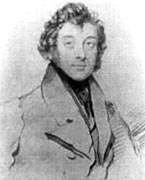


All round inventor
Gurney was born in 1793 at Treator, near Padstow. Little is known about his youth except that he attended Truro Grammar School, where he was an outstanding pupil. He is known to have met Richard Trevithick, the Cornish inventor of the first passenger carrying steam locomotive.
Not only was Goldsworthy Gurney mechanically-minded but he also was very musical and had an aptitude for medicine. He studied medicine and before he was twenty years old took over the Wadebridge practice of his tutor, Dr Avery. He married the following year. He did some experiments on sea sand, discovered the high lime content and suggested that it would be an ideal free fertiliser.
His musical talents led him to build an organ which he combined with a piano but when his invited guests listened in a warm room, parts of the instrument expanded and produced terrible discords. The following day in normal temperatures the instrument performed beautifully but the audience had gone. He later devised a piano with glass instead of wires which was shown in the Regents Park Exhibition.
In 1820, with his wife and family, he moved to London, set up as a surgeon and became lecturer to the Surrey Institution in Chemistry and Natural Philosophy. His lectures were very popular and his real inventive work began at this time. The first was the 'Oxy-hydrogen blow pipe' which was to be incorporated into many of his later works.
But by 1823 he had given up medicine to experiment with steam engines. He made a steam driven boat and a coach. In 1825 he took out a patent for a steam carriage for use on common roads. He had experimented with a model and then built a full size carriage. As nobody seemed interested in his patent, he had to manufacture the carriages himself. Soon his carriages were regularly in use around London. He fitted carriage with a steam jet but it was very noisy and too powerful. Realising that there might be customer resistance to having to sit on a boiler which was likely to explode Gurney devised the 'Drag'. This was a steam powered unit towing a separate wagon for passengers. In an exciting but successful journey to demonstrate the practicality of his invention Gurney drove the drag and trailer from London to Bath and back at fifteen miles per hour in 1829. Gurney was now established but the government put their backing behind Stephenson's new railway system.
Gurney experimented with pure lime for theatre lighting. He was successful and gave the expression "in the limelight" to the English language.
By 1859 he was back in Cornwall again and devised a powerful new light designed for ship-to-shore signalling. This same light was also used in a revolving frame of mirrors to make lighthouses identifiable from the sea by the number of their flashes.
Over the years he did much work to help miners. He ventilated mine-shafts using his steam jet to prevent the build-up of fire damp. He offered this apparatus free of charge to any owner who wanted to install it. He also gave his services when approached by the owner of a colliery in Lancashire for ideas as to how an underground fire could be extinguished. To do this he set about removing the oxygen from a pit with special apparatus which he designed for the occasion. He was made an honorary member of the North of England Institute of Mining Engineers in 1852.
Gurney was asked to light the House of Commons and he replaced the many candles with three Bude Lights, directing light around the building by means of mirrors. The system was in use for 60 years. When the new Houses of Parliament were being built in 1852 he was asked to advise on ventilation but his advice was disregarded. Later, in 1854, the Commons were dissatisfied with the ventilation and they sent for him. The windows had not been built to open so he recommended that they should be altered and installed a heating device called a Warming Battery, which he gave to the public. This could be used for heating in winter or cooling in summer.
In 1849 he helped to stem an outbreak of cholera by using his steam jet to clean out London's Friar Street sewer. In 1857 he was asked to investigate the Thames as the sewage in it and the gases escaping from it were considered a health hazard.
At last his work was recognised. In August 1863, he was knighted by Queen Victoria but unfortunately during the following October he was paralysed and spent the rest of his life in Bude, looked after by his daughter from his first marriage, Anna Jane. They lived in the house he had built at Bude Haven called The Castle. Many had predicted it would be a disaster as it had been built on sand. However Gurney was one of the first to use concrete and he had used it in the foundations of his home.
Sir Goldsworthy Gurney died on 28th February 1875 when he was 82, and was buried at Launcells Church near Bude. There is no memorial to him in Cornwall. He was a man of many talents, a philanthropist and a man whose inventions with steam, gases and electricity connected England so tightly that it was necessary for the country to keep uniform time.
In 1993 a Bi-Centenary Exhibition entitled "Bude's Forgotten Genius" was held in Gurney's "Castle on Sand" which is now the home of Bude-Stratton Town Council. A great deal of work and research went into the exhibition which includes twelve panels about 30 inches wide by 36 inches high. It is currently on display in Glasgow. A lighter, travelling exhibition assembled around slides is being prepared and will be suitable for showing all over the world.
Bude Famous Cornish People Cornwall's History Bude Castle Bude Visitor Centre